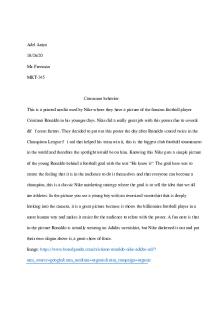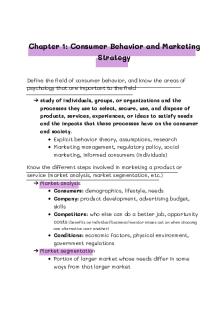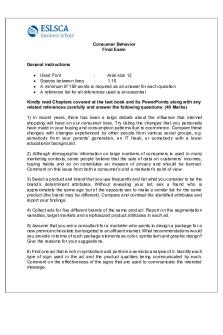MKT 302 Chapter 5 - Summary Consumer Behavior PDF

| Title | MKT 302 Chapter 5 - Summary Consumer Behavior |
|---|---|
| Course | MKT 302 Consumer behavior |
| Institution | Clemson University |
| Pages | 11 |
| File Size | 245.8 KB |
| File Type | |
| Total Downloads | 47 |
| Total Views | 148 |
Summary
chapter 5 exam study guide with notes from the book and lecture ...
Description
MKT 302 Chapter 5
Motivation the inner reasons or driving forces behind human action as consumers are driven to address real needs. Maslow’s hierarchy of needs & how it affects motivation
Utilitarian motivation A drive to acquire products that consumers can use to accomplish things o Ex. Using an air freshener to cover up a smell Utilitarian benefits in marketing o Obtain monetary savings o Reducing search & decision costs o Improved product quality because of price reduction
Hedonic Motivation Involves a drive to experience something personally gratifying o Ex. Shopping for pleasure, using an air freshener because it makes you happy Hedonic benefits in marketing o Accomplishing a sense of being a wise shopper because of sales promotions o Achieving a need for stimulation and variety when trying a brand that we might not purchase if it were not for an attractive promotion o Entertainment (contest, sweepstakes)
Consumer Involvement
Degree of personal relevance that a consumer finds in pursuing value form a given consumption act o Ex. Of high involvement: college, car, house, wedding dress
Types of consumer involvement o Products
Some people love looking at cars even if they don’t intend on buying
one o Shopping General personal relevance of shopping activities o Situation
Usually things we have no interest in until we need to (ex. Air
conditioner breaks so we research new ones) o Enduring Associated with long-term involvement, usually highly hedonic o Emotional
How emotional consumer gets during an activity Emotional Involvement The type of deep personal interest that evokes strongly felt feelings assocated with some object or activity o Ex. Sleeping stuffed animal, get bad haircut and get upset about it
Emotional expressiveness Extent to which a consumer shows outward behavioral signs and otherwise reacts
obviously to emotional experiences Emotional intelligence Capture one’s awareness of the emotions experienced in a situation, and an ability to
control reactions to these emotions Explain the multiple elements that emotional intelligence consists of: Self control-ability to control one’s emotions
Emotional empathy- ability to read and understand others emotions Upbeat- ability to maintain a generally upbeat and optimistic outlook Productive- ability to turn emotions into value through better problem solving
Semantic Wiring Consumers link concepts for memory retrieval The active process and storage of knowledge is influenced by emotions When marketing presents a product that evokes emotions, consumers recall is likely to increase Mood-Congruent Recall Events are associated with moods When a mood can be controlled by marketing, consumers evaluations of a product can be influenced Ex. Grocery stores try to evoke better mood so the consumer buys more Nostalgia Events in the past may be remembered more positively than they were in reality Consumers can make purchases based on nostalgic feelings brought up about the past by a product Ex. Ramen noodles in college; Windows Internet Explorer commercial Schema-Based Affect Emotions become stored as part of the meaning for a category Self-Conscious Emotions Specific emotions that result from some evaluation or reflection of one’s own
behavior Include pride, shame, guilt, embarrassment
Ex. Crest: if you’re not whitening, you’re yellowing Product Contamination The diminished positive feelings someone has about a product because another consumer has handled the product o Ex. Buy product in store behind the one in front.
MKT 302 Chapter 6 Personality: totality of thoughts, emotions, intentions, and behaviors that a person exhibits consistently as he or she adapts to his or her environment
Personality qualities o Unique to individual o Can be conceptualized as a combination of specific traits or characteristics o Traits are relatively stable and interact with situations to influence behavior o Specific behaviors can vary across time
What is the psychoanalytic approach? Advocated by Freud; suggests personality results from a struggle between inner motives and societal pressures to follow rules & expectations
Applicable to both motivation & personality inquiry Id: focuses on pleasure-seeking motives and immediate gratification * devil o Driven by hedonic motivation
Superego: motivates behavior that matches societal norms and expectations *angel o Works against the id
Ego: focuses on resolving conflicts o Between the id & superego
What is the trait approach? A distinguishable characteristic that describes ones tendency to act in a relatively consistent manner
Discuss important traits studied in marketing: Value consciousness: tendency for consumers to focus on maximizing what is received from a transaction as compared to what is given (ex. Penny pinchers) Materialism: extent to which material goods are important in a consumer’s life o Relationship between materialism and quality of life is negative
Innovativeness: degree to which consumers are open to new ideas o How quickly consumers adopt to buying new products, services, or experiences early in their introduction
Need for cognition: degree to which consumers tend to engage in effortful cognitive information processing
Competitiveness: defined as an enduring tendency to strive better than others o Sometimes we buy products to feel more superior than others
Self-monitoring: tendency for consumers observe and control behavior in ways that agree with social cues and influence o High self-monitors are very sensitive to others opinions & want to fit in o Low self-monitors: functionality
Define demographics observable, statistical aspects of populations including such factors as age, gender, or income can be used in conjunction with psychographic analysis Define psychographics & lifestyles psychographics: way consumers lifestyles are measured lifestyles: way people spend their time & money; useful in identifying visible market segments VALS Values & lifestyles
Survey consumers using AIO statements, which are used to gain an understanding of consumer’s activities, interests, and opinions
Classifies consumers into 8 distinct segments based on resources available to the consumer primary motivations
PRIZM Stands for Potential Ratings Index by ZIP market. People with similar backgrounds tend to live close to one another Uses 66 different segments as descriptors of individual households
Self concept Totality of thoughts and feelings that an individual has about him or himself Actual self: how we currently perceive ourselves\ Ideal self: what we would like to be Social self: how we think others perceive us
Ideal Social self: how you’d like others to view you Possible self: who/what we’d like to become
Extended self: positions we own represent us, they form our selfperception
Self Esteem: positivity of an individuals self-concept Body Esteem: positivity with which one holds their body image
Self-concept: proposes that much of consumer behavior can be explained by the congruence (match) between a consumers self-concept and
the image of typical users of a focal product Body piercings & tattoos Self-congruency theory: much of consumer behavior can be explained by the congruence of a consumers self-concept with the image of typical users of a focal product
MKT 302 Chapter 4
Factors Affecting Consumer Comprehension Characteristics of the message o Physical characteristics: the elements of a message that one senses directly
Intensity (ads are louder than the TV show, use bold font, etc.) Color (different colors evoke different feelings) Font (most well received is Helvetica)
Numbers (often signify advanced technology) Spacing (consumers have better recall if it is split over time; pistachio
commercial) Shape (consumers generally prefer “golden ratio” 1.1618) o Simplicity-complexity: the simpler the message, the more likely a consumer develops meaningful comprehension (Apple) o Congruity-incongruity: represents the extent to which a message is internally consistent and fits surrounding information (ex. Phoenix singer) Not always true that congruent content leads to improved comprehension (Red bull commercial) o Figure-ground: Figure: the focal image or the object intended to capture a person’s
attention (most important thing in a print ad) Ground: everything else that’s supporting the figure
o Message source: can influence comprehension Source influences comprehension to vary degrees based upon: Likeability Attractiveness
Expertise trustworthiness
o Shape
Characteristics of the message receiver o Intelligence/ability More intelligent= more likely to comprehend Must consider average intelligence of people you’re marketing to o Prior knowledge Ex. Golf club ad o Involvement: how close of attention consumer is paying to the message; consider targeting people with low and high involvement o Familiarity/habituation: the process by which continuous exposure to a stimulus affects the comprehension of and response to some stimulus More familiar you are with a message, the more you tend to understand Habituation is bad, zone out the commercial because you’re tired of it o Expectations: beliefs of what will happen in a future situation o Physical limits: consumers ability to hear, see, smell. Ex: hearing aids
commercial o Brain dominance: the phenomena of hemispheric laterization Right brain: visual processers; left brain: auditory Environmental characteristics o Information intensity: the amount of information available for a consumer ro process within a given environment. Ex: England girl at Walmart o Framing: the meaning of something is perceived differently by the information environment (ex. Fox, cnn) o Timing: bot the amount of time a consumer has to process a message and the point in time at which the consumer receives the message and the time of day (Billboards)
Memory Psychological process by which knowledge is recorded
Mental Processes Assisting Learning Repetition: a process in which a thought is held in short-term memory by mentally
repeating the thought (weakest form of learning) Dual coding: a process in which 2 different sensory “traces” are available to
remember something (ex. Chik fil a & cows) Meaningful Encoding: a process that occurs when preexisting knowledge is used to
assist in storing new information Chunking: a process of grouping stimuli by meaning so that multiple stimuli can become a single memory unit. o By separating disparate individual elements into larger blocks; info becomes
easier to retain and recall o Social security number, blue & white pills from video Elaboration Extend to which one continues processing a message even after he/she develops an initial understanding in the comprehension phase o Personal elaboration: is when a person imagines themselves associating with a stimulus being processed. This provides the deepest comprehension and
greatest chance of accurate recall Associative Network A network of mental pathways linking knowledge within memory Declarative Knowledge Refers to cognitive components that represent facts Represented in an associative network when 2 nodes are linked by a path o Nodes: represent concepts in the network o Paths: show the association between nodes in the network Cognitive Schemas Schema: a type of associative network that works as a cognitive representation of a
phenomenon that provides meaning to that entity Exemplar: a concept within a schema that is the single best representative of some category o Ex. McDonalds is the exemplar of fast food
Prototype: characteristics more associated with a concept o Ex. Firefighter we think of their characteristics
Additional definitions Script: a schema representing an event (fancy dining experience) Episodic memory: the memory for past events in ones life o Hearing a song reminds you of past
Social schema: aka social stereotype; cognitive representation that gives a specific type of person meaning...
Similar Free PDFs

Readings Summary - Consumer Behavior
- 62 Pages

Chapter 4 - Consumer Behavior
- 8 Pages

Consumer behavior
- 5 Pages

Consumer Behavior
- 33 Pages

Lecture 6 Consumer Behavior
- 2 Pages

Consumer Behavior Final Exam
- 2 Pages

MKT 3301 Buyer Behavior
- 11 Pages

MCQs-Consumer-Behavior
- 24 Pages

Consumer Behavior quiz
- 1 Pages

Case Study Consumer Behavior
- 3 Pages

Jada May - consumer behavior
- 5 Pages

Consumer behavior séance 2
- 5 Pages
Popular Institutions
- Tinajero National High School - Annex
- Politeknik Caltex Riau
- Yokohama City University
- SGT University
- University of Al-Qadisiyah
- Divine Word College of Vigan
- Techniek College Rotterdam
- Universidade de Santiago
- Universiti Teknologi MARA Cawangan Johor Kampus Pasir Gudang
- Poltekkes Kemenkes Yogyakarta
- Baguio City National High School
- Colegio san marcos
- preparatoria uno
- Centro de Bachillerato Tecnológico Industrial y de Servicios No. 107
- Dalian Maritime University
- Quang Trung Secondary School
- Colegio Tecnológico en Informática
- Corporación Regional de Educación Superior
- Grupo CEDVA
- Dar Al Uloom University
- Centro de Estudios Preuniversitarios de la Universidad Nacional de Ingeniería
- 上智大学
- Aakash International School, Nuna Majara
- San Felipe Neri Catholic School
- Kang Chiao International School - New Taipei City
- Misamis Occidental National High School
- Institución Educativa Escuela Normal Juan Ladrilleros
- Kolehiyo ng Pantukan
- Batanes State College
- Instituto Continental
- Sekolah Menengah Kejuruan Kesehatan Kaltara (Tarakan)
- Colegio de La Inmaculada Concepcion - Cebu



